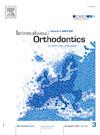II类1级患者带或不带动力臂的微型种植体支持上颌犬齿牵开的三维评估:一项裂口随机试验
IF 1.9
Q2 DENTISTRY, ORAL SURGERY & MEDICINE
引用次数: 0
摘要
本试验的主要目的是比较直接滑动(DS)和动力臂滑动(PAS)方法在犬回缩、旋转和倾斜方面的力学性能。次要目标包括评估犬的活动能力,微型植入物的稳定性和疼痛。材料和方法该裂口研究在2023年7月至2024年1月期间招募了需要拔除上颌第一前磨牙的II类1类错颌年轻成年患者,干预期为12个月。通过抛硬币的方式随机分配收放方法。封闭的螺旋弹簧施加150g的收缩力拉伸到一侧的犬齿支架钩和对侧的动力臂。分析了数字模型来测量犬的缩回率,倾斜和旋转。用骨膜试验评估犬的活动能力和微型种植体的稳定性。使用视觉模拟量表评估疼痛。数据分析采用双向混合方差分析和类内相关检验。盲法仅在数据分析时使用。结果共纳入20例患者,年龄18.35±2.85岁。DS组的总缩回率(4.42±0.75 mm)高于PAS组(2.93±0.56 mm);0.001. 与PAS和P <相比,DS的倾斜和旋转显著高于PAS;0.001, P = 0.031。两种方法在微型种植体稳定性和疼痛方面无统计学差异。然而,犬的活动度仅在第1个月和第2个月有显著差异(P = 0.005, P = 0.003), PAS组的牙周炎值更高。在试验期间没有观察到任何伤害。结论DS法比PAS法的牵入速度快。然而,PAS方法有效地减少了倾斜和旋转,促进了犬在缩回过程中更可控的身体运动。在Clinical-Trial.gov注册试验,识别号为NCT06352996。本文章由计算机程序翻译,如有差异,请以英文原文为准。
Three-dimensional assessment of mini-implant supported maxillary canine retraction with and without power arm in class II division 1 patients: A split-mouth randomized trial
Introduction
The primary objectives of this trial were to compare the mechanics of direct sliding (DS) and power arm sliding (PAS) methods for canine retraction in regard to the rate of retraction, rotation, and tipping. The secondary objectives included the evaluation of canine mobility, mini-implant stability, and pain.
Material and methods
This split-mouth study was conducted over a 12-month intervention period on young adult patients with Class II Division 1 malocclusion requiring extraction of the maxillary first premolars, recruited between July 2023 and January 2024. Retraction methods were randomly assigned to sides by coin toss. Closed coil springs applying 150 g retraction forces were stretched to the canine bracket hook on one side and the power arm on the contralateral side. Digital models were analysed to measure canine retraction rate, tipping, and rotation. Canine mobility and mini-implant stability were assessed with the periotest. The pain was evaluated using a visual analogue scale. Data were analysed using two-way mixed ANOVA, and intraclass correlation test. Blinding was only used during data analysis.
Results
Twenty patients (aged 18.35 ± 2.85) were included. The total retraction rate was greater in DS (4.42 ± 0.75 mm) compared to PAS (2.93 ± 0.56 mm) with P < 0.001. Tipping and rotation were significantly higher in DS compared to PAS with P < 0.001, P = 0.031, respectively. No statistically significant differences were observed between the 2 methods regarding mini-implant stability, and pain. However, canine mobility revealed a significant difference only during the first and second months (P = 0.005, P = 0.003, respectively) with higher periotest values recorded in the PAS group. No harm was observed during the trial.
Conclusions
The DS method resulted in a faster rate of retraction than the PAS method. However, the PAS method effectively reduced both tipping and rotation, facilitating a more controlled bodily movement during canine retraction.
Trial registration in Clinical-Trial.gov under identification number NCT06352996.
求助全文
通过发布文献求助,成功后即可免费获取论文全文。
去求助
来源期刊

International Orthodontics
DENTISTRY, ORAL SURGERY & MEDICINE-
CiteScore
2.50
自引率
13.30%
发文量
71
审稿时长
26 days
期刊介绍:
Une revue de référence dans le domaine de orthodontie et des disciplines frontières Your reference in dentofacial orthopedics International Orthodontics adresse aux orthodontistes, aux dentistes, aux stomatologistes, aux chirurgiens maxillo-faciaux et aux plasticiens de la face, ainsi quà leurs assistant(e)s. International Orthodontics is addressed to orthodontists, dentists, stomatologists, maxillofacial surgeons and facial plastic surgeons, as well as their assistants.
 求助内容:
求助内容: 应助结果提醒方式:
应助结果提醒方式:


